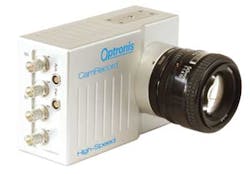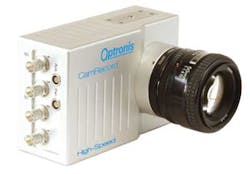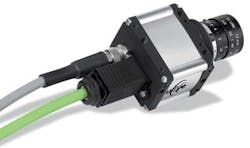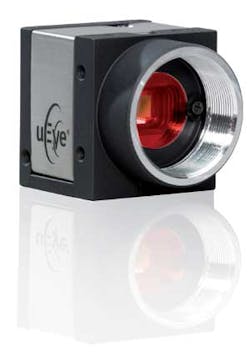Camera Vendors Leverage CMOS Imagers
Vendors employ off-the-shelf and custom CMOS area-array imagers to pioneer new designs for wide-ranging imaging applications
Andrew Wilson, Editor
During the past decade, many articles have been written detailing the performance characteristics and benefits of CCD and CMOS imagers. Initially, the promise that CMOS imagers were less expensive to fabricate and were expected to facilitate a higher level of system integration while featuring quantum efficiency, noise levels, and dynamic ranges similar to their CCD counterparts was somewhat exaggerated. In recent years, CMOS sensors have shown image-quality improvements and manufacturers are leveraging their higher speed, lower power requirements, and greater integration potential in a range of novel cameras and camera systems.
Intent on developing devices for large consumer markets such as cellular telephones and mobile computers, many semiconductor companies entered the CMOS imaging market either by designing their own devices or acquiring specialized CMOS design houses. Today, the few companies that are still pursuing the mobile market are developing multimegapixel, back-illuminated devices with pixel sizes of 1.1 μm or less—despite the fact that no commercially available consumer lens can possible resolve such detail (see R. Fontaine, “A Review of the 1.4 μm Pixel Generation,” http://bit.ly/rdAgcj).
To address more specialized machine-vision and image-processing markets, other vendors have leveraged the benefits offered by CMOS fabrication techniques to meet the demands of low-power, high-resolution, intelligent or low-light-level/high-dynamic-range applications.
Embedded imaging
In medical imaging systems, the low power and compact size of imagers allows developers of products such as endoscopes to replace older, analog-based systems with digital camera systems. Many CMOS imager vendors are now offering products that allow digital endoscopes to be produced in a cost-effective manner. Companies such as Awaiba, AltaSens, and OmniVision have all developed imagers specifically targeted to such low-cost, lower-power applications.
One of the first companies to announce such a product, Awaiba, offers the NanEye—a 140 × 140-pixel CMOS imager measuring 540 × 500 μm that can produce 8-bit/pixel images at up to 40 frames/s. OmniVision also offers a CMOS imager, the OV6930, specifically targeted at the medical image-processing market. With a packaged footprint of 1.8 × 1.8 mm, OmniVision's OV6930 is a 1/10-in. array that operates at up to 30 frames/s at 400 × 400 HVGA or 60 frames/s at 400 × 200 pixels. The imager is already being used in two medical device modules from COMedia Ltd.
In a larger 1/3-in. format, the ProCamHD 2462 imaging system-on-chip (iSoC) sensor from AltaSens features a 1280 × 720-pixel, 60-frames/s imager with an integrated 12-bit ADC, allowing high-definition digital images to be output directly from the sensor. According to AltaSens, the device has been used by MGB Endoscopy in the design of its MD-V endoscopy camera. By employing sophisticated, miniaturized CMOS imagers, medical system developers can reduce the parts count—and thus size—associated with this type of camera system, simultaneously reducing the cost of their products.
High-speed applications
Embedded medical applications are just one of the areas now taking advantage of CMOS imager characteristics. Many industrial machine-vision and motion-control applications require very high-speed imagers with global shutters and high pixel resolution. Again, CMOS imager vendors such as Alexima, CMOSIS, and ON Semiconductor are responding to this demand with an array of products that have been integrated into high-speed cameras.
Currently, Alexima offers two CMOS imagers targeted at high-speed image capture. The AM41 is a 4-Mpixel, 500-frames/s global shutter CMOS sensor that, at a reduced resolution of 1920 × 1080 pixels, can achieve rates as high as 1000 frames/s.
Alexima's most recent image sensor, the Am1X5, is targeted at even higher frame rates. Featuring a 1k × 1k-pixel, 5000-frames/s digital CMOS sensor and a global shutter, the device has recently been incorporated into the Y4, a high-speed camera from IDT that is capable of running at 3000 frames/s with 1016 × 1016-pixel resolution.
To maintain the bandwidth available with these sensors, many camera manufacturers have incorporated the latest high-speed interfaces in their products. Miktrotron has incorporated the Camera Link HS standard into the EoSens 4CL HS AM41-based camera to allow transfer of images to a host computer at 2.1 Gbytes/s.
Like Mikrotron, Optronis has also incorporated the AM41 into its high-speed camera, the CL4000CXP (see Fig. 1). Rather than use the Camera Link HS interface, Optronis has chosen to transfer data from the camera to the PC using four CoaXPress data channels. With this data transfer speed, the 4-Mpixel CMOS camera can be clocked at 500 frames/s. Another approach taken by VDS Vosskühler (now part of Allied Vision Technologies) in its AM41-based CMC-4000 camera to achieve 400 frames/s at the full 4-Mpixel resolution is to use two readout channels that separately transmit left and right data regions from the imager, employing two 10-bit Camera Link outputs. Because of this, either a frame grabber with two 10-tap Camera Link inputs or two separate frame grabbers, each with a single 10-tap input, are required.
CMOSIS has found a number of customers for its CMV2000 and CMV4000 image sensors. Both devices feature pipelined global shutter, correlated double sampling, and 16 channels of LVDS output; the CMV2000 features an image format of 2048 × 1088 pixels and can be clocked to produce 340 frames/s in 10-bit mode, and the 2048 × 2048-pixel CMV4000 can run at up to 180 frames/s.
To date, a number of Camera Link offerings incorporate these CMOSIS devices: They include Adimec's CMV4000-based Quartz Qs-4A40 and CMV2000-based Qs-2A80; Basler's CMV2000-based acA2000-340km/kc and CMV4000-based acA2040-180km/kc; and Point Grey's Gazelle camera series.
After acquiring the CMOS image sensor line from Cypress Semiconductor, ON Semiconductor has also found success for its line of high-resolution image sensors among camera vendors. One of the most impressive of these, the VITA 25K, offers 5120 × 5120-pixel resolution, pipelined global shutter, and 53 frames/s at full resolution. Higher frame rates can be achieved using windowed or sub-sampled readout modes.
At the 2010 Technical Exhibition on Image Technology and Equipment held in Japan, Edec Linsey System announced it had developed a camera based on the VITA 25K image sensor. Dubbed the VIS-1001-PM, the camera uses a Full Camera Link interface to deliver 20 frames/s at full 5120 × 5120-pixel resolution.
Dynamic range
While many camera vendors are using the latest CMOS imagers in embedded and high-speed applications, others are leveraging the high dynamic ranges that can be achieved using the devices.
Photonfocus has used its own A1312 imager in the MV1-D1312-240-CL-8, a Camera Link camera that features a 1248 × 1082-pixel imager that can operate at 200 frames/s at full resolution while achieving a dynamic range of up to 120 dB.
Other camera vendors such as Red Shirt Imaging and Imaging Development Systems (IDS) are employing devices from providers such as Imager Labs and New Imaging Technologies (NIT).
Both Red Shirt Imaging and IDS have produced cameras capable of resolving changes in light intensity from both very bright and relatively dim regions within the same field. Red Shirt Imaging has used a custom CMOS imager from Imager Labs to develop the NeuroCMOS-SM, a series of cameras for high- and medium-light-level measurements that can operate at speeds as fast as 10,000 frames/s with a 21-bit dynamic range.
IDS has opted to integrate a wide-dynamic-range (WDR) image sensor from NIT into both its 768 × 576-pixel UI-5120SE GigE and UI-1120SE USB 2.0 cameras (see Fig. 2). Using the WDR imager, both cameras achieve a dynamic range of 120 dB.
Though there is still high demand for cameras based on CCD imagers, the speed, cost, and integration advantages of CMOS imagers enable camera differentiation while offering added functionality. Embedded and high-dynamic-range applications will easily benefit from advances in CMOS imager designs; however, the numerous camera interfaces such as USB 3.0, CoaXPress, 10GigE, and Camera Link HS—although fast—may still be limited in terms of their capability to support future generations of high-speed CMOS-based cameras.
Company Info
Adimec
Eindhoven, the Netherlands
www.adimec.com
Alexima
Pasadena, CA, USA
www.alexima.com
AltaSens
Westlake Village, CA, USA
www.altasens.com
Awaiba
Madeira, Portugal
www.awaiba.com
Basler
Ahrensburg, Germany
www.baslerweb.com
CMOSIS
Antwerp, Belgium
www.cmosis.com
COMedia
Hong Kong, China
www.comedia.com.hk
Edec Linsey System
Toyohashi, Japan
www.edeclinsey.jp
IDT
Tallahassee, FL, USA
www.idtpiv.com
Imager Labs
Monrovia, CA, USA
www.imagerlabs.com
Imaging Development Systems
Obersulm, Germany
www.ids-imaging.com
MGB Endoscopy
Berlin, Germany
www.mgb-berlin.de
Mikrotron
Unterschleissheim, Germany
www.mikrotron.de
New Imaging Technologies
Verrières le Buisson, France
www.new-imaging-technologies.com
OmniVision
Santa Clara, CA, USA
www.ovt.com
ON Semiconductor
Phoenix, AZ, USA
www.onsemi.com
Optronis
Kehl, Germany
www.optronis.com
Photonfocus
Lachen, Switzerland
www.photonfocus.com
Point Grey Research
Richmond, BC, Canada
www.ptgrey.com
Red Shirt Imaging
Decatur, GA, USA
www.redshirtimaging.com
VDS Vosskühler, part of Allied Vision Technologies
Osnabrück, Germany
www.vdsvossk.de
Vision Systems Articles Archives



